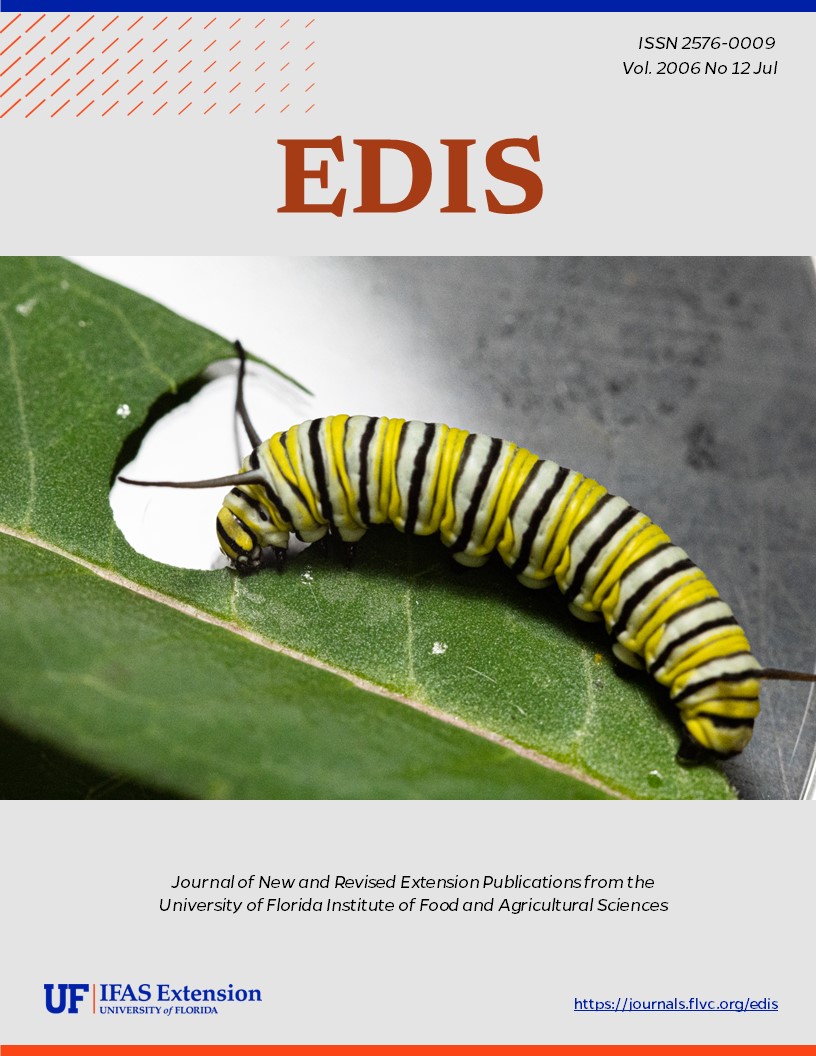Abstract
ENY-726, a 4-page illustrated fact sheet by Kevin Kobylinski and Roxanne Rutledge Connelly, describes this potentially fatal, chronic disease and the triatomine bugs that transmit it. It discusses the low risk of contracting the disease in Florida or from contaminated blood, and information on control measures. Includes references. Published by the UF Department of Entomology and Nematology, July 2006.
References
Beard, C., G. Pye, F. Steurer, R. Rodriquez, R. Campman, P. Townsend, J. Ramsey, R. Wirtz and L Robinson. 2003. Chagas Disease in a Domestic Transmission Cycle in Southern Texas, USA. Emerging Infectious Diseases. 9:103-105. https://doi.org/10.3201/eid0901.020217
Beard, C., D. Young, J. Butler, and D. Evans. 1988. First isolation of Trypanosoma cruzi from a wild-caught Triatoma sanguisuga (LeConte) (Hemiptera: Triatominae) in Florida, U.S.A. Journal of Parasitology. 74:343-344. https://doi.org/10.2307/3282467
Bradley, K., D. Bergman, P. Woods, J. Crutcher, and L. Kirchhoff. 2000. Prevalence of American trypanosomiasis (Chagas disease) among dogs in Oklahoma. Journal of the American Veterinary Medical Association. 217:1853-1857. https://doi.org/10.2460/javma.2000.217.1853
Burkholder, J., T. Allison, and V. Kelly. 1980. Trypanosoma cruzi (CHAGAS) (PROTOZOA: KINETOPLASTIDA) in invertebrate, reservoir, and human hosts of the lower Rio Grande valley of Texas. Journal of Parasitology. 66:305-311. https://doi.org/10.2307/3280824
Davis, D., L. Russell and L. Adams. 1980. An experimental infection of Trypanosoma cruzi in striped skunks (Mephitis mephitis). Journal of Wildlife Disease. 16:403-406. https://doi.org/10.7589/0090-3558-16.3.403
Miles, M. 1983. The epidemiology of South American trypanosomiasis - biochemical and immunological approaches and their relevance to control. Transactions of the Royal Society of Tropical Medicine and Hygiene. 77:5-23. https://doi.org/10.1016/0035-9203(83)90004-4
Mott, K., Mota, E., Sherlock, I., Hoff, R., Muniz, T., Oliveira, T. and C. Draper. 1978. Trypanosoma cruzi infection in dogs and cats and household seroreactivity to T. cruzi in a rural community in northeast Brazil. American Journal of Tropical Medicine and Hygeine. 27:1123-1127. https://doi.org/10.4269/ajtmh.1978.27.1123
Mullen, G. and L. Durden. 2002. Medical and Veterinary Entomology. Academic Press. pp. 69-80.
Pest Management. 1995. Conenose Kissing Bugs. Pest Management. 14:35-36.
Pippin, W. 1970. The biology and vector capability of Triatoma sanguisuga texana Usinger and Triatoma gerstaeckeri (STAL) compared with Rhodnius prolixus (STAL) (HEMIPTERA: TRIATOMINAE). Journal of Medical Entomology. 7:30-45. https://doi.org/10.1093/jmedent/7.1.30
Pippin, W. 1969. American trypanosomiasis transmission and vector effectiveness studies. USAF Epidemiological Laboratory and the Oklahoma State University. pp.22.
Pung, O., C. Banks, D. Jones, and M. Krissinger. 1995. Trypanosoma cruzi in wild raccoons, opossums, and triatomine bugs in southeast Georgia, USA. Journal of Parasitology. 81:324-326. https://doi.org/10.2307/3283947
World Health Organization Expert Committee. 1991. Control of Chagas Disease. WHO Technical Report Series. 811.
Yaeger, R. 1988. The prevalence of Trypanosoma cruzi infection in armadillos collected at a site near New Orleans, Louisiana. American Journal of Tropical Medicine and Hygiene. 38:323-326. https://doi.org/10.4269/ajtmh.1988.38.323

